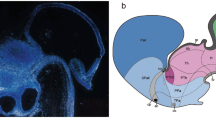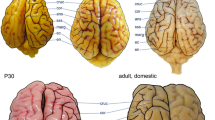Summary
In the present study the morphogenesis of the ventricular ridges, i.e. the site of origin for neurons in the basal ganglia and various related basal forebrain structures, has been studied in the Chinese hamster with the aid of three-dimensional and graphical reconstructions. The first ridge appears at developmental stage 14 (E12 1/2). It originates at the level of the torus hemisphaericus, thereby obscuring the basal part of the telodiencephalic boundary. Later on this ridge passes into the medial ventricular ridge. Subsequently, the lateral ventricular ridge arises at stage 16 (E13 1/2). Initially, both ridges are completely separated by the sulcus subpallii intermedius. During further development, however, this limiting groove fades away, a process starting caudally and gradually proceeding in the rostral direction. Eventually, this process results in the formation of one single ventricular eminence at the second fetal stage (E18). In the adult stage the ventricular eminence curves around the cerebral stem area. Thickening of the telencephalic walls and local coarctations have considerably reduced the lumen of the lateral ventricle. The preoptic region in the adult must be considered as a derivative of the diencephalic part of the medial ventricular ridge.
Similar content being viewed by others
References
Ariëns Kappers, C.U.: The ontogenetic development of the corpus striatum in birds and a comparison with mammals and man. Proc. Roy. Acad. Sci. (Amsterdam) 26, 135–158 (1923)
Bartelmez, G.W., Dekaban, A.S.: The early development of the human brain. Contrib. Embryol. Carneg. Instn. 37, 13–32 (1962)
Brown, J.W.: The development of the amygdaloid complex in insectivorous bat embryos. Ala. J. Med. Sci. 4, 399–415 (1967)
Donkelaar, H.J. ten, Dederen, P.J.W.: Neurogenesis in the basal forebrain of the Chinese hamster (Cricetulus griseus) I. Time of neuron origin. Anat. Embryol. 156, 331–348 (1979)
Donkelaar, H.J. ten, Geysberts, L.G.M., Dederen, P.J.W.: Stages in the prenatal development of the Chinese hamster (Cricetulus griseus). Anat. Embryol. 156, 1–28 (1979)
Donkelaar, H.J. ten, Lammers, G.J., Gribnau, A.A.M.: Neurogenesis in the amygdaloid nuclear complex in a rodent (the Chinese hamster). Brain Research 165, 348–353 (1979)
Gaunt, W.A.: Microreconstruction. London: Pitman Medical (1971)
Gribnau, A.A.M., Geÿsberts, L.G.M.: Morphogenesis of the prosencephalon in staged rhesus monkey embryos, in preparation
Gribnau, A.A.M., Lammers, G.J.: The preparation of graphical and three-dimensional reconstructions of the developing central nervous system. Acta Morphol. Neerl. Scand. 14, 1–18 (1976)
Grönberg, G.: Die Ontogenese eines niedern Säugergehirns nach Untersuchungen an Erinaceus europaeus. Zool. Jahrb. Anat. Abth. 15, 261–384 (1901)
Grünthal, E.: Untersuchungen zur Ontogenese und über den Bauplan des Gehirns. In: Beiträge zur Entwicklungsgeschichte und normalen Anatomie des Gehirns (K. Feremutsch and E. Grünthal, eds.) pp. 5–32. Basel: S. Karger 1952
Hamilton, W.J., Boyd, J.D., Mossman, H.W.: Human embryology. Cambridge: W. Heffer 1972
Hewitt, W.: The development of the human caudate and amygdaloid nuclei. J. Anat. (Lond.) 92, 377–382 (1958)
Hewitt, W.: The development of the human internal capsule and lentiform nuclei. J. Anat. (Lond.) 95, 191–199 (1961)
Hines, M.: Studies on the growth and differentiation of the telencephalon in man: the fissura hippocampi. J. Comp. Neur. 34, 73–171 (1922)
His, W.: Die Entwicklung des menschlichen Gehirns während der ersten Monate. Leipzig: S. Hirzel 1904
Hochstetter, F.: Beiträge zur Entwicklungsgeschichte des menschlichen Gehirns. Teil I. Wien: F. Deuticke 1919
Humphrey, T.: The development of the human amygdala during early embryonic life. J. Comp. Neur. 132, 135–165 (1968)
Johnston, J.B.: Further contributions to the study of the evolution of the forebrain. J. Comp. Neur. 35, 337–382 (1923)
Kahle, W.: Die Entwicklung der menschlichen Großhirnhemisphäre. Berlin: Springer 1969
Källén, B.: The nuclear development in the mammalian forebrain with special regard to the subpallium. Kgl. Fysiogr. Sällsk. Lund Handl. N. F. 61, nr. 9, 1–43 (1951)
Keyser, A.J.M.: The development of the diencephalon of the Chinese hamster. Acta Anat. 83 Suppl. 59, 1–178 (1972)
Kodama, S.: Über die sogenannten Basalganglien. Schweiz. Arch. Neurol. Psychiat. 19, 152–177 (1926)
Kuhlenbeck, H.: Die Grundbestandteile des Endhirns im Lichte der Bauplanlehre. Anat. Anz. 67, 1–51 (1929)
Kuhlenbeck, H.: The human diencephalon. A summary of development, structure, function and pathology. Confin. Neurol. Suppl. 14, 1–230 (1954)
Kupffer, C. von: Die Morphogenie des Centralnervensystems. In: Handbuch der vergleichenden und experimentellen Entwicklungslehre der Wirbeltiere (O. Hertwig, ed.) Jena: Fischer 1906
Mihalkovicz, V. von: Entwicklungsgeschichte des Gehirns. Leipzig: Engelmann 1877
Romeis, B.: Mikroskopische Technik. München: Oldenbourg 1968
Rose, J.E.: The ontogenetic development of the rabbit's diencephalon. J. Comp. Neur. 77, 61–130 (1942)
Spatz, H.: Zur Ontogenese des Striatums und des Pallidum. Dtsch. Z. Nervenheilk. 81, 185–188 (1924)
Spatz, H.: Über die Entwicklungsgeschichte der basalen Ganglien des menschlichen Großhirns. Anat. Anz. 60, 54–58 (1925)
Tandler, J., Kantor, H.: Beiträge zur Entwicklungsgeschichte des Vertebratengehirns. Anat. Hefte 33, 553–662 (1907)
Tiedemann, F.: Anatomie und Bildungsgeschichte des Gehirns. Nürnberg: Stein 1816
Vaage, S.: The segmentation of the primitive neural tube in chick embryos (Gallus domesticus). Ergebn. Anat. Entwickl.-Gesch. 41, 1–88 (1969)
Westergard, E.: The cerebral ventricles of the guinea pig during growth. Acta Anat. 70, 382–402 (1968)
Westergard, E.: The lateral ventricles and the ventricular walls. Thesis. Odense (1970)
Ziehen, T.: Morphogenie des Centralnervensystems der Säugetiere. In: Handbuch der vergleichenden und experimentellen Entwicklungslehre der Wirbeltiere (O. Hertwig, ed.) Jena: Fischer 1906
Author information
Authors and Affiliations
Additional information
The present study forms part of a thesis (1976 University of Nijmegen) entitled ‘On the development of the strio-amygdaloid complex of the Chinese hamster’ by Dr. G.J. Lammers (present address: Catharina Hospital, Dept. of Neurology, Eindhoven, The Netherlands)
Rights and permissions
About this article
Cite this article
Lammers, G.J., Gribnau, A.A.M. & ten Donkelaar, H.J. Neurogenesis in the basal forebrain in the Chinese hamster (Cricetulus griseus). Anat Embryol 158, 193–211 (1980). https://doi.org/10.1007/BF00315906
Accepted:
Issue Date:
DOI: https://doi.org/10.1007/BF00315906




